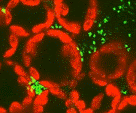Plant Pathology Department
Document Type
Article
Date of this Version
12-8-2021
Citation
JOURNAL OF NEMATOLOGY. e2022-1 | Vol. 54. DOI: 10.2478/jofnem-2022-0009
Abstract
DNA barcoding with the mitochondrial COI gene reveals distinct haplotype subgroups within the monophyletic and parthenogenetic nematode species, Mesocriconema xenoplax. Biological attributes of these haplotype groups (HG) have not been explored. An analysis of M. xenoplax from 40 North American sites representing both native plant communities and agroecosystems was conducted to identify possible subgroup associations with ecological, physiological, or geographic factors. A dataset of 132 M. xenoplax specimens was used to generate sequences of a 712 bp region of the cytochrome oxidase subunit I gene. Maximum-likelihood and Bayesian phylogenies recognized seven COI HG (≥99/0.99 posterior probability/bootstrap value). Species delimitation metrics largely supported the genetic integrity of the HG. Discriminant function analysis of HG morphological traits identified stylet length, total body length, and stylet knob width as the strongest distinguishing features among the seven groups, with stylet length as the strongest single distinguishing morphological feature. Multivariate analysis identified land cover, ecoregion, and maximum temperature as predictors of 53.6% of the total variation (P = 0.001). Within land cover, HG categorized under “herbaceous,” “woody wetlands,” and “deciduous forest” were distinct in DAPC and RDA analyses and were significantly different (analysis of molecular variance P = 0.001). These results provide empirical evidence for molecular, morphological, and ecological differentiation associated with HG within the monophyletic clade that represents the species Mesocriconema xenoplax.


Comments
Open access.